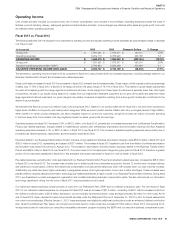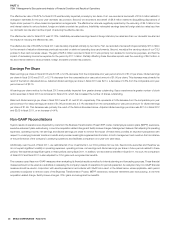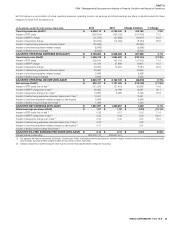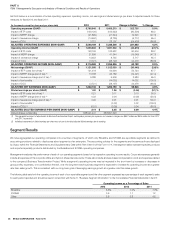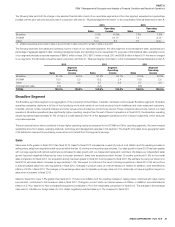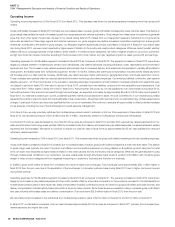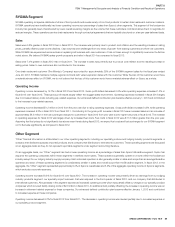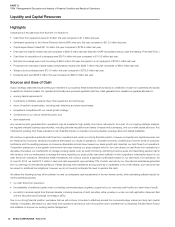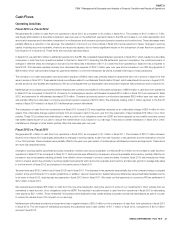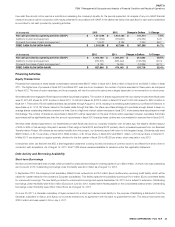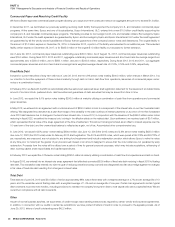Sysco 2013 Annual Report Download - page 39
Download and view the complete annual report
Please find page 39 of the 2013 Sysco annual report below. You can navigate through the pages in the report by either clicking on the pages listed below, or by using the keyword search tool below to find specific information within the annual report.SYSCO CORPORATION-Form10-K28
PARTII
ITEM7Management’s Discussion and Analysis ofFinancial Condition and Results of Operations
Operating Income
Operating income decreased by 0.6% in scal 2013 from scal 2012. This decrease was driven by operating expenses increasing more than gross pro t
dollars.
Gross pro t dollars increased in scal 2013 primarily due to increased sales; however, gross pro t dollars increased at a lower rate than sales. This decline in
gross margin was partially the result of increased growth from large regional and national customers. Gross margin from these types of customers is generally
lower than from other types of customers. As seen in our results during scal 2013, if sales from our independent restaurant customers do not grow at the
same rate as sales from these large regional and national customers, our gross margins may decline. Increased competition resulting from a slow-growth
market also contributed to the decline in gross margins. Our Broadline segment experienced product cost in ation in scal 2013. Based on our product sales
mix during scal 2013, we were most impacted by higher levels of in ation in the poultry and meat product categories. While we cannot predict whether
in ation will occur, prolonged periods of high in ation, either overall or in certain product categories, can have a negative impact on us and our customers,
as high food costs can reduce consumer spending in the food-away-from-home market, and may negatively impact our sales, gross pro t and earnings.
Operating expenses for the Broadline segment increased in scal 2013 as compared to scal 2012. The expense increases in scal 2013 were driven
largely by charges related to multiemployer pension plan withdrawals, pay-related expenses including severance costs, depreciation and amortization
expense and fuel. The increase in pay-related expenses was primarily due to increased delivery and warehouse compensation, partially attributable to
case growth, and added costs from companies acquired in the last 12months. Delivery and warehouse compensation includes activity-based pay which
will increase when our case volumes increase. Additionally, pay rates have been higher particularly in geographies where oil and gas exploration occurs.
These increases were partially offset by reduced sales and information technology pay-related expenses. Our enhanced de ned contribution plan became
effective January1,2013 and contributed to the increase in operating expenses. Depreciation and amortization increased primarily from assets that were
not placed in service in scal 2012 that were in service in scal 2013, primarily from new facilities, property from new acquisitions and expansions. Fuel
costs were $16.7million higher in scal 2013 than in scal 2012. Assuming that fuel prices do not rise signi cantly over recent levels during scal 2014,
fuel costs exclusive of any amounts recovered through fuel surcharges, are expected to increase by approximately $5million to $15million as compared to
scal 2013. Our estimate is based upon current, published quarterly market price projections for diesel, the cost committed to in our forward fuel purchase
agreements currently in place for scal 2014 and estimates of fuel consumption. Actual fuel costs could vary from our estimates if any of these assumptions
change, in particular if future fuel prices vary signi cantly from our current estimates. We continue to evaluate all opportunities to offset potential increases
in fuel expense, including the use of fuel surcharges and overall expense management.
From time to time, we may voluntarily withdraw from multiemployer pension plans to minimize or limit our future exposure to these plans. In scal 2013 and
scal 2012, we recorded provisions of $41.9million and $21.9million, respectively, related to multiemployer pension plan withdrawals.
Our scal 2013 cost per case decreased by more than $0.03 per case as compared to scal 2012 primarily from reduced pay-related expenses from our
sales and information technology areas, partially offset by increased costs from delivery and warehouse pay-related expenses, increased retirement-related
expenses and fuel increases. We expect to continue to reduce our cost per case in scal 2014 by approximately $0.05 per case partially from reduced
retirement-related expenses.
Operating income increased by 3.8% in scal 2012 over scal 2011. This increase was driven by gross pro t dollars increasing more than operating expenses.
Gross pro t dollars increased in scal 2012 primarily due to increased sales; however, gross pro t dollars increased at a lower rate than sales. This decline
in gross margin was primarily the result of product cost in ation and competitive pressures on pricing. Based on Broadline’s product sales mix for scal
2012, wewere most impacted by higher levels of in ation in the meat, canned and dry and frozen product categories. While we are generally able to pass
through modest levels of in ation to our customers, we were unable pass through fully these higher levels of product cost in ation with the same gross
margin in these product categories without negatively impacting our customers’ business and therefore our business.
In addition, gross pro t dollars for scal 2012 increased as a result of higher fuel surcharges. Fuel surcharges were approximately $39.1million higher in
scal 2012 than the prior year due to the application of fuel surcharges to a broader customer base during scal 2012 due to higher fuel prices incurred
during these periods.
Operating expenses for the Broadline segment increased in scal 2012 as compared to scal 2011. The expense increases in scal 2012 were driven
largely by an increase in pay-related expenses and fuel costs, partially offset by a favorable comparison in the provisions recorded for the withdrawal from
multiemployer pension plans in each scal year. Sales compensation includes commissions which are driven by gross pro t dollars and case volumes, and
delivery compensation includes activity-based pay which is driven by case volumes. Since these drivers are variable in nature, increased gross pro t dollars
and case volumes will increase sales and delivery compensation. Fuel costs were $26.5million higher in scal 2012 than the prior year.
We recorded provisions related to the withdrawal from multiemployer pension plans of $21.9million in scal 2012 and $41.5million in scal 2011.
In scal 2012, our Broadline companies cost per case increased approximately $0.04 per case as compared to scal 2011 primarily from increased pay-
related expenses and higher fuel costs.





